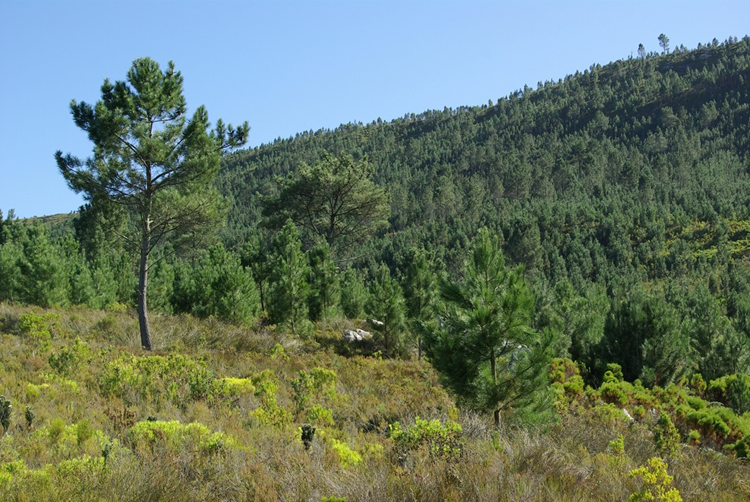Invasive alien trees such as pines, acacias and eucalyptus in South Africa are a critical threat to biodiversity, water supplies and productive use of land. In order to address this problem an ambitious and internationally-praised governmental programme has been in place for almost three decades – Working for Water (WfW). While it helped the country to slow down the propagation of the main invasive alien species with land clearing operations, it is still far from achieving its objectives with about 20 million hectares invaded at varying densities.
It remains the exception that the biomass from the invasive trees is subsequently used and processed despite a myriad of possible end-products. In fact most of the time it is reported that the wood is left on site and decays or burns, which in turn leads to greenhouse gas emissions. This situation calls to mind because it ignores opportunities to create value and support the national economy, and it fails to contribute to climate change mitigation. Yet the country faces a severe energy crisis and the establishment of bioenergy value chains would help; besides, such biomass could also be turned into biochar with the potential to not only store carbon in the soils but also makes agriculture more resilient for better adaptation to climate change.
Another element supports the view that value-added industries may have a positive role to play for the control of invasive alien trees (eradication may not be within reach due to their widespread and aggressive nature). Indeed, restoration-oriented land clearing programs are assumed to be most efficient in sparsely invaded areas where further invasions can be prevented at reasonable costs. By contrast, processing industries would need to operate where invasions are dense enough to limit biomass supply costs and provide sufficient amounts of the feedstock.
The School for Climate Studies is engaging in research activities to assess and define the role of value-added industries (Pirard, 2023). This idea has been around for some time but without clear decisions on the way forward. The risks of engaging in this direction with more investments by the private sector have always made it controversial. For instance, some argue that harvesting operations for the purpose of biomass supplies tend to create more damage than solutions due to their profit-oriented nature and tendency to be opportunistic with no consideration for sustainable land management. Others go further and point to the risk of a perverse effect as the establishment of increased demand for woody biomass and related economic interests might create resistance against resource eradication: in other words, one does not saw the branch on which they sit.
But these claims are poorly substantiated and tend to rely on anecdotical evidence at best in the case of invasive trees in South Africa; they could even be dismissed by on-going experiments where a value-added industry relies exclusively on operations certified by the Forest Stewardship Council (FSC). Our findings tend to provide a more nuanced view, which is also informed by on-going debates in the case of invasive animal species. For instance, the “eat it or not eat it” dilemma has been discussed at length for many species and the development of food value chains remain a classical strategy, e.g. for lionfish in the Caribbean; their impacts have been limited, if any, but not particularly negative.
An interesting point in this regard is the lock-in effect due to the integration of invasive species in local cultures such as for wild horses in the American Southwest. This phenomenon would find some resonance in the case of invasive trees because it is common that rural communities in South Africa enjoy invasive trees due to the various goods and services provided, of which woodfuel and shade are obvious examples.
A bigger problem might be the feasibility of such value-added industries. In the literature most feasibility studies face two major shortcomings that diminish the robustness and relevance of their conclusions. First, they tend to include and mix different things with financial flows on one hand and economic benefits in the form of environmental services on the other. This is a problem because the former are tangible and result in bills to be paid, whereas the latter are societal benefits (“externalities” in economic lingo) without impact on cash flows or profits at the company level. This means that results are mostly theoretical and by no means an indicator of the ability to invest by the private sector.
Second, these studies are usually made ex ante and use questionable assumptions, for instance they use standard values for supply costs which stand as the main cost item. Yet only an assessment of operations on the ground would provide credible results with more reliance on primary data collection. All this means that published information are poor indicators of the viability of value-added industries.
Some elements suggest that bioenergy value chains based on invasive alien trees face a strong competition by fossil fuels for two main reasons: relatively high costs of biomass supplies due to the nature of the resource, which is scattered, heteregenous, poorly mapped, uncertain, among other characteristics; and the lack of an enabling policy environment. Indeed, for various reasons that range from the historical role of trade unions in the coal mining sector, vast and cheap domestic coal resources, the lack of political will to alter the competitiveness of the economy with more expensive energy, there is a lack of voluntarist policies to support renewable energies in general and bioenergy in particular. This is perfectly illustrated by the very low levels of the carbon tax whose implementation has also been delayed.
Value-added industries merit to be supported because they can be seen as vehicles of both climate change adaptation and mitigation respectively with a more sustainable use of land / enhanced provision of environmental services (water availability in particular), and energy substitution or carbon storage in the soils with biochar or related products. The rationale is that public policies could improve access to the resource, e.g. with better coordination with the WfW programme that would bear the burden of land clearing operations, or the dissemination of updated and reliable information about the resource availability (a type of “public good” on open access).
Public policies could also increase the profitability of investments by changing the relative prices, e.g. applying a higher carbon tax that would penalise alternative fossil fuels. The deal is that such supportive policies would lead, in exchange, to a stricter monitoring of operations on the ground with high expectations from harvesting companies in terms of sustainable operations and post-removal treatment, e.g. with investments in restoration.
The School for Climate Studies is eager to continue its research efforts to support this process. One avenue is to understand how to harness carbon pricing mechanisms – the most mature and operational market for environmental services to date – which appears to be a very complex issue that is tied to carbon accounting rules and paradigm (e.g. methodologies of existing standards differ in their approaches). Another avenue is to undertake impact evaluations of value-added industries to document the impacts of the demand for biomass on harvesting and post-removal operations, and in turn on land condition and the propagation of invasive alien trees. A third avenue is to explore if and why the harvesting of invasive alien trees leads to significantly higher biomass supply costs than commercial plantations; this information would inform policies and action to reduce such costs and improve access to the resource at scale. It is currently being addressed through surveys among stakeholders involved in the supply chains.
These avenues for research will partly be undertaken in the framework of the Horizon Europe project MarginUp! that runs until 2025 (https://margin-up.eu/).
Read the paper published in International Forestry Review.
For more information, contact Romain Pirard at pirardr@sun.ac.za


